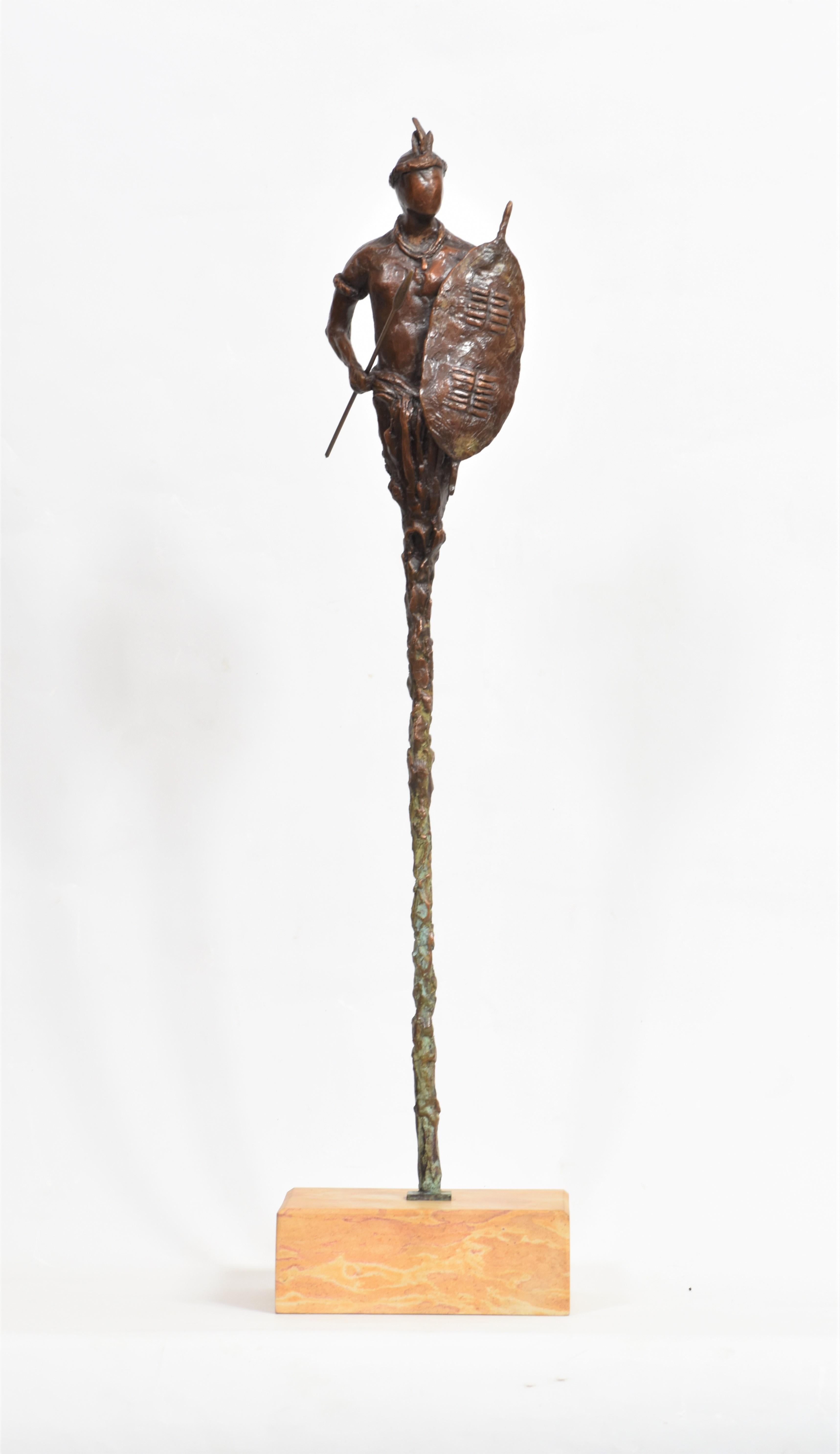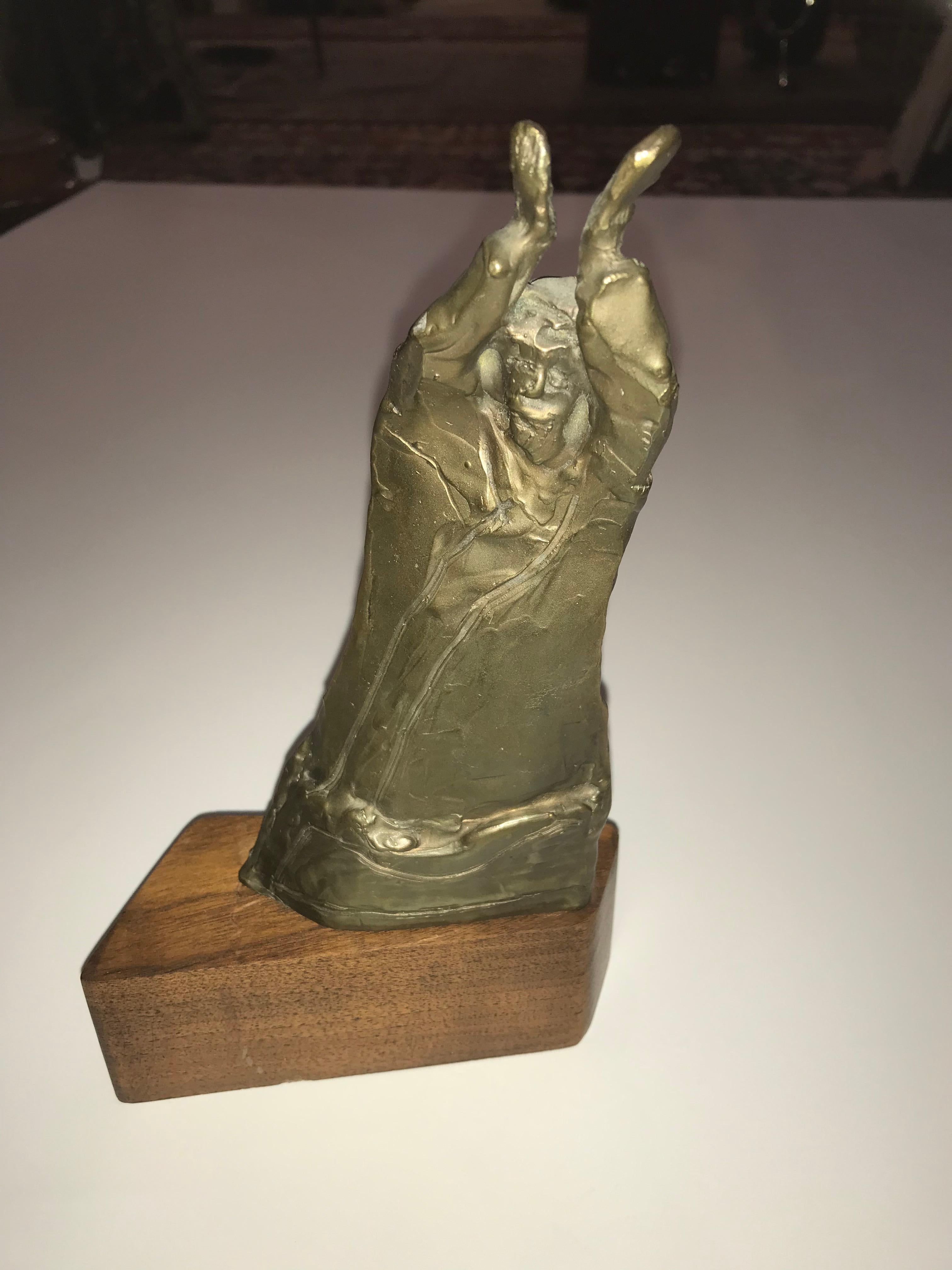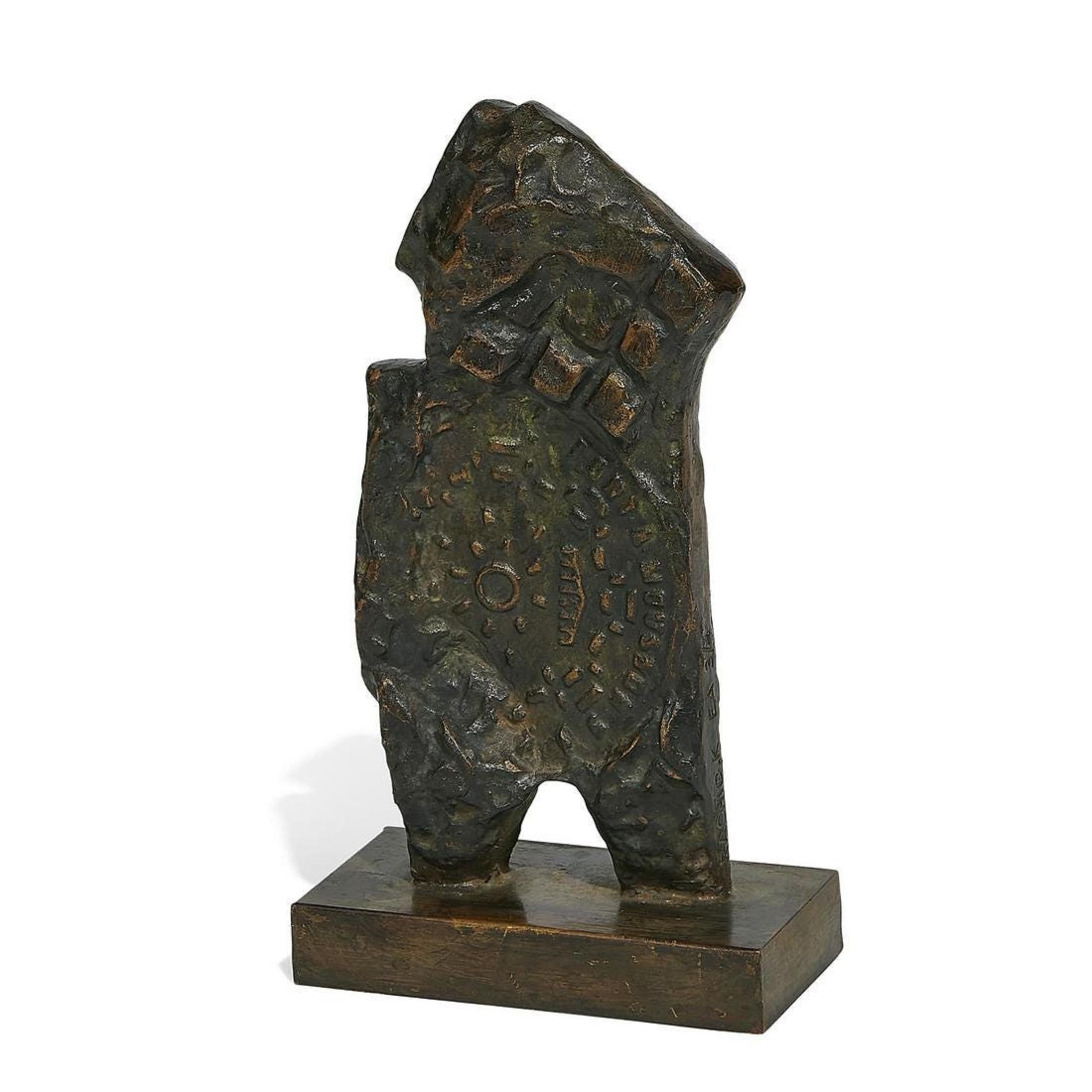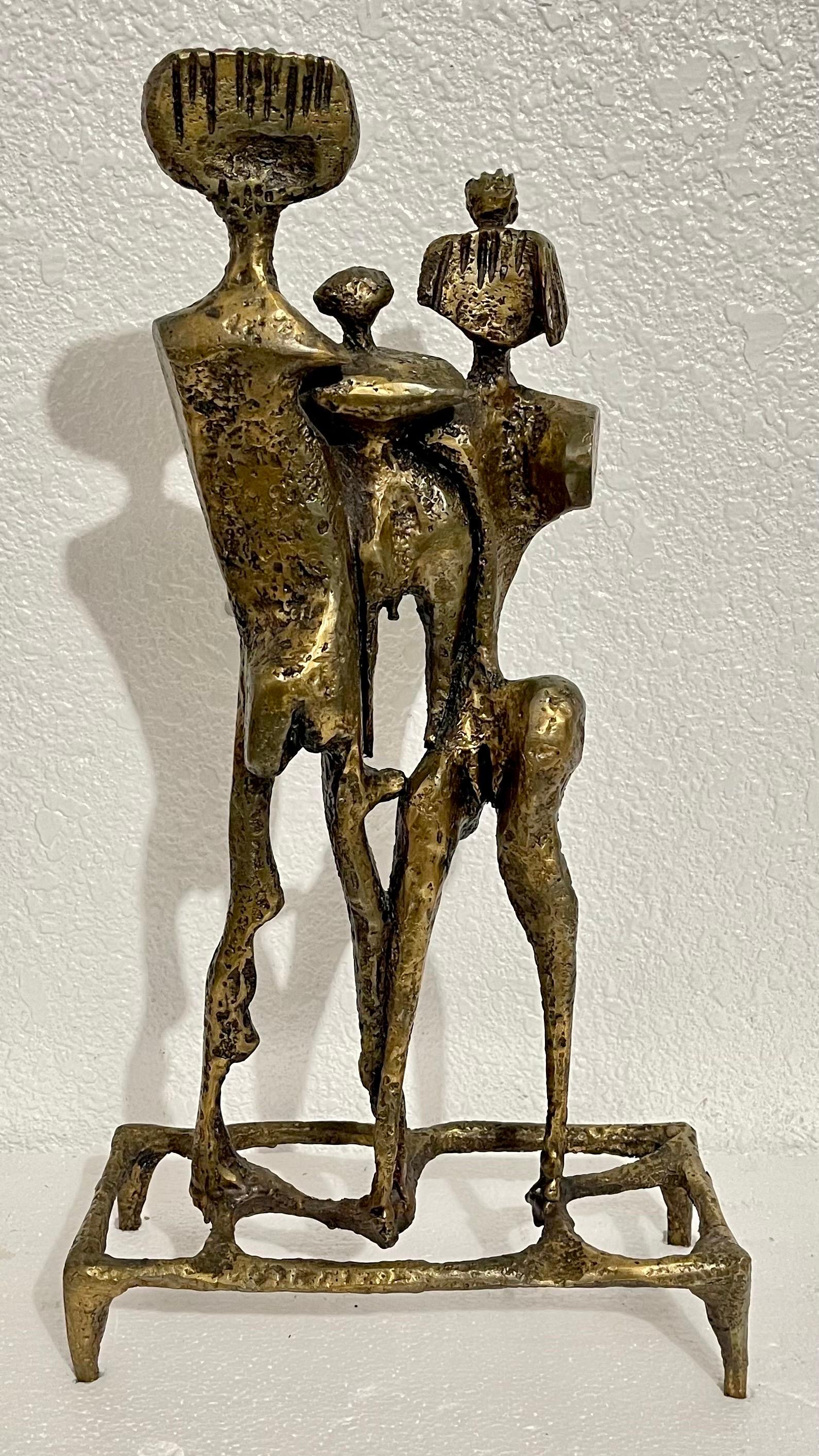Items Similar to Homodeus
Want more images or videos?
Request additional images or videos from the seller
1 of 5
Nikolas TsorpatzidisHomodeus2019
2019
About the Item
Inspired by the writings of historian Yuval Noah Harari, Homo Deus creates a vision of the future: of Man physically transformed by new technologies to the point of attaining a status of immortality, thus becoming a homo deus (a human god). Caught between two states of being, the figure is starting to lose its shape transcending its worldly form and promising a bright future for the human species. A utopian dream harboring many hopes but also a warning about the ethical use of these pioneering ideas in the field of medicine.
Nikola’s minimalistic sculptures are usually made of bronze, wood or marble and range from unique big size outdoor pieces, to small ones in limited editions. His oeuvre encompasses human figures, mythology, and fantasy. Figures inspired by Greek history or extraterrestrial myths, usually coated with various patinas as an experiment of understanding how the same work may be perceived by the viewer in different ways. According to the artist: "It is the constantly present challenges, when I harness hard materials, that push me to explore new methods and innovative techniques, in my effort to realize my ideas in small, medium and large scale".
Nikolas is deeply concerned about the position of the human race in a future defined by machine learning and our co-existence with androids and cyborgs. His work is, therefore, an expression of his beliefs and feelings for the future of humanity. His sculptures are also influenced by the countries from the four continents in which he has lived in throughout his life. "Wherever I travel, I always absorb and process how people interact with their world, especially in places outside the Western canon of living and thinking", says the artist. That is why, apart from history and mythology, elements from indigenous peoples are often incorporated in his artworks.
- Creator:Nikolas Tsorpatzidis (1961, Greek)
- Creation Year:2019
- Dimensions:Height: 19.49 in (49.5 cm)Width: 12.6 in (32 cm)Depth: 10.24 in (26 cm)
- Medium:
- Movement & Style:
- Period:
- Condition:
- Gallery Location:Spetses, GR
- Reference Number:
About the Seller
No Reviews Yet
Vetted Seller
These experienced sellers undergo a comprehensive evaluation by our team of in-house experts.
Established in 2016
1stDibs seller since 2022
- ShippingRetrieving quote...Ships From: Spetses, Greece
- Return PolicyA return for this item may be initiated within 30 days of delivery.
More From This SellerView All
- ExoplanetsLocated in Spetses, GRSpace, the final frontier. From the dawn of civilization man tries to reach for the stars. Is there someone out there or are we alone is this vast universe? This work speaks about the great insecurity we feel as a species when we think about life in other planets...Category
21st Century and Contemporary Abstract Expressionist Figurative Sculptures
MaterialsBronze
- JanusLocated in Spetses, GRJanus in the Roman god of beginnings and endings, of time and duality. He always has two faces looking simultaneously to the past and the future. Nikola’s Janus encapsulates the mean...Category
21st Century and Contemporary Contemporary Abstract Sculptures
MaterialsBronze
- Lady with red roseBy Sotos ZachariadisLocated in Spetses, GRA stylish lady with a red rose pinned on her black dress is sitting in a retro armchair. A new series (2023) from SOTOS_Z Zachariades. Portraits of live...Category
21st Century and Contemporary Expressionist Portrait Paintings
MaterialsOil, Cardboard
- untitledLocated in Spetses, GRDrips and layered acrylic paint on this portrait by George Alekou. Alekou is creating a series of figurative artworks on paper, inspired by various real ...Category
21st Century and Contemporary Expressionist Portrait Drawings and Waterc...
MaterialsPaper, Ink, Acrylic
- Hot lipsLocated in Spetses, GRI consider each colored dot to be like a person. You and me and everyone. Together we all make up that image shown. You will notice that in my work all the dots are spread out evenly...Category
21st Century and Contemporary Pop Art Abstract Paintings
MaterialsEnamel
- Locking eyes on youLocated in Spetses, GRPortrait created with separate, round, colored dots. Original artwork by Dimitri Likissas, black frame included. Certificate of authenticity will be p...Category
21st Century and Contemporary Pop Art Portrait Paintings
MaterialsEnamel
You May Also Like
- Zulu Warrior - African Bronze Sculpture - Limited EditionLocated in Pretoria, ZAZulu Warrior in Bronze with traditional patina. Limited edition of 24 (signed & numbered), Sculpture in Bronze Verdigris on Sandstone base. Height 70 cm including base. My art is ins...Category
2010s Expressionist Figurative Sculptures
MaterialsSandstone, Bronze
- Standing Man by Mildred KouzelLocated in Pasadena, CAOriginal Art Work By California Recent Artist Standing Man, 1981 Mildred Kouzel's first career was in nursing: she was an army nurse during World War II...Category
Mid-20th Century Expressionist Figurative Sculptures
MaterialsBronze
- Rachid Khimoune French Algerian Arab Art Brut Bronze Sculpture Abstract FigureLocated in Surfside, FLRachid Khimoune (Algerian, b. 1953) Les enfants du monde bronze. signed and numbered artist's edition of 4 foundry mark - L. Cappe 7.5 x 4.63 x 2.38 Overall: 8.25 x 4.63 x 2.38 RACHID KHIMOUNE, Algerian-French artist and sculptor. Born in 1953 in Decazeville, France. Lives and works in Paris, France. Rachid Khimoune graduated from the School of Art of Paris in 1974; he initially started to work with painting before choosing sculpture. In 1980 he won the first prize of the Foundation of France. He works in an Art Brut, Naif art style similar to Jean Dubuffet and Enrico Baj. Being the recipient of numerous prestigious awards and an extensive oeuvre, Rachid Khimoune has been exhibiting since 1975 and his work can be found in several museums, and public and private collections. The artist behind the project Rachid Khimoune, has been responsible for a number of major, successful public art installations in France. Most famously, the installation close to the Bibliothèque Nationale (National Library) ‘Les Enfants du Monde’ (The Children of the World). Rachid’s newer works are masks and totems cast in bronze: poetic images forged in a furnace. Rachid uses discarded objects and disused parts of machines, to create new human and animal forms. Here his interest in metal-working and Arab art-African art coincides with the assemblage of found objects; one mask is a collage constituted by a large model of the Eiffel Tower stuck into the end of a trumpet. Another has a jerry-can for a face, and the golden patina and surface-working of the bronze does not dispel the idea which this image creates: of a human mouth drinking oil. Born in France to parents from Algeria, Khimoune embraces the role of the artist as a global citizen, using art as a universal language. Select Awards Lauréat du Prix de la Fondation de France (1980) Chevalier des Arts et Lettres (2002) Grande Médaille de la Ville de Paris (2004) Chevalier de la Légion d’Honneur (2007) EXHIBITIONS SOLO EXHIBITIONS 2017 Ar[T]senal, Dreux, France 2016 Musée Tavet Delacour, Pontoise, France 2015 Parvis de l’Hotel de ville, Paris 2015 Beirut Art Fair, Beyrouth, Liban 2015 Galerie Francoise Souchaud, Lyon 2014 Musée Rabelais, Seuilly, France 2013 Galerie Vallois...Category
20th Century Expressionist Abstract Sculptures
MaterialsBronze
- Large Aharon Bezalel Israeli Modernist Bronze Brutalist Puzzle Sculpture FiguresBy Aharon BezalelLocated in Surfside, FLAharon Bezalel (Afghani-Israeli, 1925-2012) 1984 Edition 4/9 Family Grouping Hand signed in Hebrew with initials and in English Movable figures that fit together like puzzle pieces in solid cast bronze with original patina on a lucite bench base. 23 X 19 X 6 base is 24 X 6 X 6 Aharon Bezalel (born Afghanistan 1926) Born in Herat, Afghanistan in 1926 and immigrated to Israel at an early age. His father, Reuven Bezalel, was a rabbi and kabbalist. As a youth Aharon studied gold and silver casting as well as applied arts and worked in these fields as a silversmith and judaica craftsman, and was a student of the sculptor Zev Ben-Zvi at the Bezalel Academy for Art & Design where he also studied with Isidor Ascheim and Mordecai Ardon. There he absorbed the basic concepts of classic and modernist art and interpreted, according to them, ideas based on ancient Hebrew sources. He also studied miniature carving with the artists Martin and Helga Rost applying himself at their workshop. Aharon Bezalel worked and resided in Jerusalem, he taught art for many years. His sculptures - works of wood, bronze, aluminum, Plexiglas - were shown at his studio in Ein Kerem. “I saw myself as part of this region. I wanted to find the contact between my art and my surroundings. Those were the first years of Jean Piro’s excavations at the Beer-Sheba mound. They found there, for example, the Canaanite figurines that I especially liked and that were an element that connected me with the past and with this place.” “…a seed and sperm or male and female. These continue life. The singular, the individual alone, cannot exist; I learned this from my father who dabbled with the Kabbalah.” (Aharon Bezalel, excerpt from an interview with David Gerstein) “The singular in Aharon Bezalel’s work is always potentially a couple if not a threesome, the one is also the many: when the individual is revealed within the group he will always seek a huddling, a clinging together. The principle of modular construction is required by this perception of unity and multiplicity, as modular construction in his work is an act of conception or defense. His work bears a similarity to Berrocal as well as affinities to Henry Moore, Lynne Chadwick and Kenneth Armitage. Two poles of unity, potentially alone, exist in A. Bezalel’s world: From a formal, sculptural sense these are the sphere and pillar, metaphorically these are the female in the final stages of pregnancy and the solitary male individual. Sphere-seed-woman; Pillar-strand-man. The disproportional, small heads in A. Bezalel figures leave humankind in it’s primal physical capacity. The woman as a pregnancy or hips, the man as an aggressive or defensive force, the elongated chest serves as a phallus and weapon simultaneously. (Gideon Ofrat) EIN HAROD About the Museum's Holdings: Israeli art is represented by the works of Reuven Rubin, Zaritzky, Nahum Gutman...Category
Mid-20th Century Expressionist Abstract Sculptures
MaterialsBronze
- Maasai Warrior - African Sculpture in Bronze Verdigris - Limited EditionLocated in Pretoria, ZAMaasai Warrior in Bronze Verdigris on Sandstone base, limited edition of 24 (signed and numbered); H 76 cm including base. Having been a professional safari guide, my art is influenc...Category
2010s Expressionist Figurative Sculptures
MaterialsSandstone, Bronze
- Large Aharon Bezalel Israeli Modernist Bronze Brutalist Puzzle Sculpture FiguresBy Aharon BezalelLocated in Surfside, FLAharon Bezalel (Afghani-Israeli, 1925-2012) Family Grouping Hand signed in with initials in English Figures fit together like puzzle pieces in solid cast bronze with original patina. Aharon Bezalel (born Afghanistan 1926) Born in Herat, Afghanistan in 1926 and immigrated to Israel at an early age. His father, Reuven Bezalel, was a rabbi and kabbalist. As a youth Aharon studied gold and silver casting as well as applied arts and worked in these fields as a silversmith and judaica craftsman, and was a student of the sculptor Zev Ben-Zvi at the Bezalel Academy for Art & Design where he also studied with Isidor Ascheim and Mordecai Ardon. There he absorbed the basic concepts of classic and modernist art and interpreted, according to them, ideas based on ancient Hebrew sources. He also studied miniature carving with the artists Martin and Helga Rost applying himself at their workshop. Aharon Bezalel worked and resided in Jerusalem, he taught art for many years. His sculptures - works of wood, bronze, aluminum, Plexiglas - were shown at his studio in Ein Kerem. “I saw myself as part of this region. I wanted to find the contact between my art and my surroundings. Those were the first years of Jean Piro’s excavations at the Beer-Sheba mound. They found there, for example, the Canaanite figurines that I especially liked and that were an element that connected me with the past and with this place.” “…a seed and sperm or male and female. These continue life. The singular, the individual alone, cannot exist; I learned this from my father who dabbled with the Kabbalah.” (Aharon Bezalel, excerpt from an interview with David Gerstein) “The singular in Aharon Bezalel’s work is always potentially a couple if not a threesome, the one is also the many: when the individual is revealed within the group he will always seek a huddling, a clinging together. The principle of modular construction is required by this perception of unity and multiplicity, as modular construction in his work is an act of conception or defense. His work bears a similarity to Berrocal as well as affinities to Henry Moore, Lynne Chadwick and Kenneth Armitage. Two poles of unity, potentially alone, exist in A. Bezalel’s world: From a formal, sculptural sense these are the sphere and pillar, metaphorically these are the female in the final stages of pregnancy and the solitary male individual. Sphere-seed-woman; Pillar-strand-man. The disproportional, small heads in A. Bezalel figures leave humankind in it’s primal physical capacity. The woman as a pregnancy or hips, the man as an aggressive or defensive force, the elongated chest serves as a phallus and weapon simultaneously. (Gideon Ofrat) EIN HAROD About the Museum's Holdings: Israeli art is represented by the works of Reuven Rubin, Zaritzky, Nahum Gutman...Category
Mid-20th Century Expressionist Abstract Sculptures
MaterialsBronze




